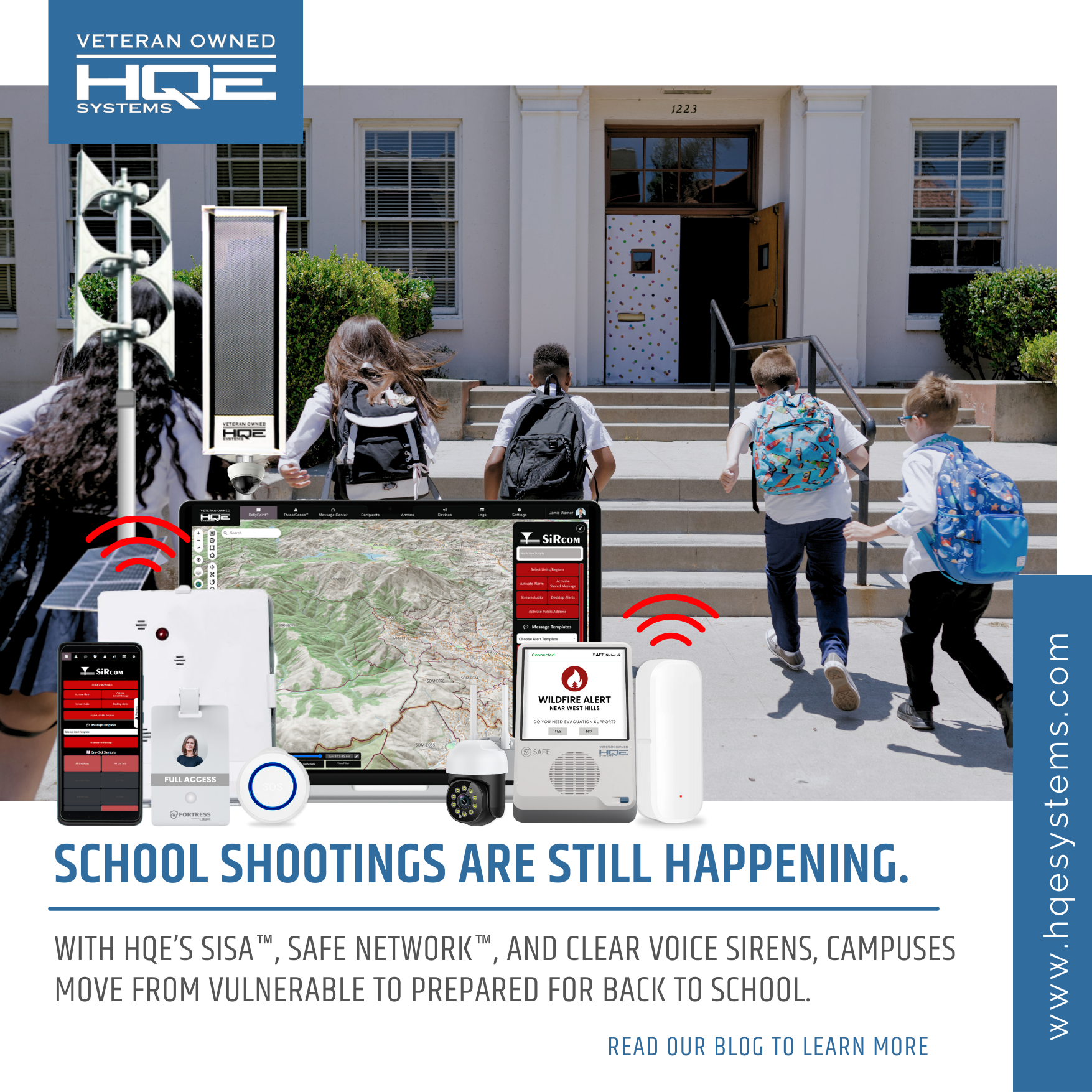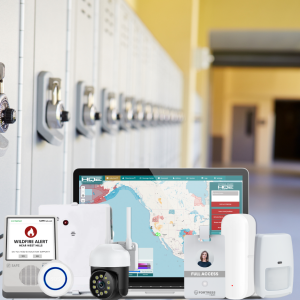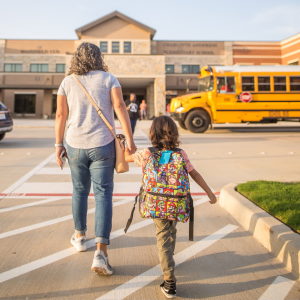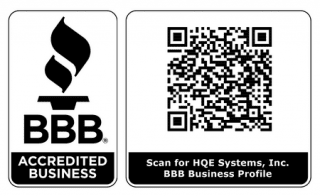Are Our Schools Truly Ready?
School shootings have become one of the most pressing threats to education in the United States. From Antioch High School in Tennessee to dozens of other campuses, each tragedy highlights a devastating reality: students and teachers are not only vulnerable but often left without clear communication when crisis strikes. Parents wait for hours with no information. Teachers are forced to improvise. Communities are left broken. These events are not isolated, nor are they slowing down. Every headline is a reminder that campuses must move beyond outdated plans and adopt systems that save lives when seconds matter most.
High Stakes, Real Threats
School shootings in 2025 have revealed that no campus is immune from violent, life threatening moments. These incidents are not random. They expose where systems fail and where smart solutions must step in.
Annunciation Catholic Church and School, Minneapolis, Minnesota (August 27, 2025)
During a Mass marking the start of the school year, a 23-year-old gunman opened fire with a rifle through church windows, killing two children and injuring 18 others, most of them students between 6 and 15 years old. Police reported the shooter was armed with multiple weapons and fired more than 100 rounds before dying by suicide at the scene. Families and parishioners were left devastated, with local hospitals treating critically wounded children and elderly parishioners. Federal officials are investigating the attack as a hate crime and act of domestic terrorism. CBS News coverage of the Minneapolis shooting details the heartbreaking loss and emerging facts.
Florida State University, Tallahassee, Florida (April 17, 2025)
Originally seen as safe and routine, campus life shattered when a 20 year old student opened fire in the Student Union. Two food service employees were killed and six others were wounded. Students scrambled for safety, even using gum to stick paper over windows as they hid. The shooter was swiftly detained by university police. This shooting demonstrated how rapidly tragedy can unfold, even in college settings. NBC News carried deeply personal accounts and broader implications.
Wilmer Hutchins High School, Dallas, Texas (April 2025)
During another school day, a student bypassed building security and opened fire in a hallway, injuring four male students during class. This was the second shooting at the same school in under a year, compounding community anxiety around recurring threats. The incident was documented in AllSides, noting systemic vulnerabilities that persist when protocols fail.
These three incidents share a disturbing pattern:
- Surprise and speed: Each occurred when safety was assumed, such as lunchtime, the Student Union, and passing through a hallway, leaving no time to react.
- Communication breakdowns: Schools often lacked effective, unified alert systems. Delays or confusion in notifying staff and students during those crucial seconds can change outcomes.
- Trauma beyond the incident: Communities are left to rebuild trust. Students, educators, and families need confidence that next time, systems will hold.
The broader context confirms what these events highlight. Education Week found seven K–12 shooting incidents resulting in injuries or deaths this year so far. That number is part of a larger trend. Since 2018 there have been more than 220 such incidents. (Education Week)
For school boards and emergency managers, these data points are sobering. They show that the stakes are not only high, they are growing. What was once seen as extreme is now painfully commonplace. It is no longer sufficient to rely on outdated drills or reactive measures. Modern challenges require integrated, real time systems that deliver direction when seconds count.
The Scope of the Crisis
The three tragedies described above are not isolated. They are part of a much larger pattern that shows how deeply school shootings have become embedded in the landscape of American education. According to the K-12 School Shooting Database, incidents now include not only active shooter events but also any discharge of a firearm on school property. This broader definition makes clear just how common the threat has become and how often campuses are forced to respond to life threatening situations.
Recent numbers underscore the reality. As reported by Everytown Research, there were 207 incidents of gunfire on school grounds in 2025 alone, resulting in 63 deaths and 69 injuries nationwide. Nearly 40 percent of those injured or killed were students. Each number represents a child, a family, and a community forced to grapple with trauma that lingers long after the event itself.
The impact goes beyond immediate victims. The K-12 School Shooting Database shows that shootings occur across every type of school—public, private, urban, suburban, and rural. No community is immune. Campuses that once believed “it could never happen here” are now counted among the growing list of schools forever changed by gun violence.
The burden falls heavily on students and educators. Teachers must balance instruction with safety drills. Parents drop their children off each morning with quiet fear. Students report higher levels of anxiety and hypervigilance, shaped by lockdown practices and the knowledge that shootings are no longer rare exceptions.
The problem is compounded by how quickly these incidents unfold. According to Everytown for Gun Safety, most school shootings last only a few minutes. That brevity leaves almost no margin for hesitation. Systems that are slow, fragmented, or unclear cannot keep pace with the speed of violence.
The data paints a stark picture: school shootings are happening more often, impacting more children, and leaving deeper scars. Plans on paper are not enough. Schools must have tools that can deliver clear, immediate communication to everyone on campus, tools that do not break down under pressure, and tools that restore some measure of trust for parents and educators.
Where Preparedness Breaks Down
For emergency managers, the difficult truth is that schools often have safety plans on paper but those plans do not withstand the stress of a real event. Drills are practiced and binders are updated, yet in the middle of a crisis, gaps appear where pressure, confusion, and human behavior collide.
Lack of Unified Command
During emergencies, multiple agencies arrive almost immediately, including law enforcement, fire, EMS, and district leadership. Without a unified communication system, each relies on its own radios or phones, leading to wasted minutes while families, teachers, and students wait for guidance. As reported by News Channel 5, delays in information during the Antioch High incident turned into confusion that spread across the community.
Overreliance on Manual Processes
Many campuses still depend on handwritten rosters, word of mouth, or emails that may not reach everyone in time. According to the K-12 School Shooting Database, many school shootings unfold in less than five minutes. By the time an email is written and sent, the critical moment may already have passed.
Reunification Bottlenecks
Even when the immediate threat is contained, reunification often creates a second crisis. Families flood designated sites demanding answers. Without digital accountability, staff resort to paper lists while misinformation spreads. Everytown Research shows that the trauma from shootings does not end when the gunfire stops, and disorganized reunification only adds to the damage.
Language and Accessibility Gaps
In many emergencies, communication is issued in only one language. For diverse school populations, this leaves entire groups of families in the dark. Multilingual communication is not optional. It is essential for trust and safety.
The Takeaway for Emergency Managers
The breakdown is not from a lack of planning but from a lack of systems designed to withstand stress. Emergencies do not provide time to troubleshoot radios, translate emails, or update rosters. Resilience requires tested, automated, and unified platforms that remove guesswork and provide clear communication under any condition.
Smarter Systems, Safer Schools
Every story of confusion during a tornado drill, every parent waiting helplessly during a reunification failure, and every teacher left without direction underscores the same point: schools need smarter, proven systems that do not break when the pressure is highest. HQE Systems steps into this gap with technology built for one purpose: saving lives.
A Unified Campus Approach
Sirens and outdoor alerts alone are no longer enough to protect today’s campuses. Schools need a layered system that connects every space including classrooms, cafeterias, offices, gyms, and playgrounds. HQE delivers a unified platform that brings together
Gunshot Detection that instantly verifies threats and automatically triggers lockdown alerts
Indoor PA and Digital Signage that provide clear instructions through voice and visual displays so students and staff know exactly what to do
Desktop Alerts for Staff that push urgent pop-up messages to teachers and administrators without delay
Phone Alerts that deliver calls and text messages directly to students, parents, and staff so critical instructions reach everyone wherever they are
Panic Buttons that allow staff to discreetly summon help or activate lockdown procedures with one touch
By combining these technologies into a seamless framework, schools eliminate the dangerous gaps that often create confusion when seconds matter most.
SiSA Unified Mass Notification Platform
SiSA is the backbone of this approach. Instead of relying on disconnected tools, it allows school leaders to send real-time alerts across every channel simultaneously including sirens, PA systems, phone calls, text and email notifications, desktop pop-ups, mobile devices, and digital signage. SiSA integrates directly with gunshot detection and panic button triggers, converting critical moments into immediate protective action. To ensure inclusivity, SiSA supports more than 120 languages and is fully ADA compliant so parents, students, and staff receive instructions they can both understand and access, no matter their needs.
FORTRESS Real-Time Tracking Badges
FORTRESS badges extend safety to the individual level. These wearable devices provide real-time tracking across campus so leaders know exactly where students and staff are located during an emergency. Each badge is equipped with a built-in panic button, allowing any teacher or staff member to instantly send a distress signal if they witness or experience a threat. This creates accountability, situational awareness, and immediate escalation when help is needed most.
SAFE Network
When power grids collapse or cell service is overwhelmed, the SAFE Network ensures alerts continue through independent satellite and redundant channels. Families, students, and educators remain informed regardless of infrastructure failure.
Clear Voice Sirens
Outdoor sirens remain one of the most trusted alerting tools. HQE’s Clear Voice Sirens broadcast tones and live voice instructions that carry over noise, terrain, and severe weather. Whether mounted in a rural district or a dense city campus, these sirens cut through panic with clear direction.
Real World Deployments
HQE’s systems are field-proven in some of the world’s most demanding environments. More than 50 Department of Defense installations worldwide rely on these technologies to protect lives.
In Paradise, California, advanced alerting tools rebuilt community trust after devastating wildfires.
In Clearwater, Florida, 26 outdoor sirens and lightning detection alerts safeguarded residents and visitors when Hurricane Helene struck, ensuring critical warnings reached the public even as infrastructure faltered.
Compliance and Reliability You Can Trust
HQE solutions meet FEMA IPAWS, NDAA, and TAA standards and are fully ADA compliant. This ensures every district can purchase with confidence, knowing the systems meet federal requirements and provide accessibility for all. Backed by a 99.99 percent uptime guarantee, schools can trust that alerts will be delivered without interruption.
Why It Matters Now
The rising tide of disasters, both natural and man-made, makes one truth clear. The old way of preparing is not enough. Static plans and fragmented systems cannot keep pace with modern threats. HQE Systems offers resilient, integrated solutions proven to deliver direction when every second counts.
Smarter systems create safer schools. Safer schools save lives.
Take Action Before It Is Too Late
Every school shooting headline is a reminder that the next crisis could unfold without warning. These events reveal the same painful truth: when alerts are delayed, when communication fails, and when plans collapse under pressure, lives are at risk. Schools cannot afford to wait and hope.
Preparation is not about if an emergency happens but when. Each day without stronger systems increases the chance that students, teachers, and families will face fear and confusion instead of clarity and direction.
HQE Systems delivers solutions designed specifically for the moments when seconds matter most. Our platforms connect with gunshot detection sensors to trigger instant alerts and lockdown instructions. They provide communication in more than 120 languages, ensuring no student or parent is left in the dark. Alerts are sent across sirens, PA systems, mobile devices, emails, texts, and digital signage simultaneously. Trusted by military bases, city governments, and schools across the country, these tools perform in the environments where failure is not an option.
Now is the time to evaluate preparedness. Strong safety plans paired with proven technology can transform fear into confidence and save lives when the unthinkable happens. The opportunity to act is today, not after the next tragedy makes headlines.
Protecting the Future Starts Now
Every emergency proves the same truth: communication saves lives. From prevention to response, what matters most is how quickly and clearly schools can act. HQE Systems is ready to help campuses move beyond outdated systems and into proven solutions that protect students, teachers, and families. Do not wait for the next crisis to expose the gaps. Contact HQE today to explore the best path forward.
HQE Systems is a certified Veteran Owned Company. For more information about HQE Systems Inc. and its emergency management, electronic security, and integration solutions, please visit www.hqesystems.com.

Contact: David Ditto (Early Warning Systems Subject Matter Expert)
Email: David.Ditto@hqesystems.com
Phone Number: (843) 872-7020
____________________
HQE Systems, Inc. | HQE is a Minority-Owned Service Disabled Veteran Owned Small Business (SDVOSB) providing full solutions for: Mass Notification Systems, Electronic Security Systems, Software Development Services, Contract Support, and Prototyping Services. As a brand-agnostic solutions provider, HQE prides itself in providing the BEST solution for the project. HQE possesses over 30+ factory certifications and reseller licenses to ensure our clients receive the highest quality service at the ideal budget. HQE can provide full design, installation, integrations, upgrades, and long-term maintenance support for any size and scope project.







